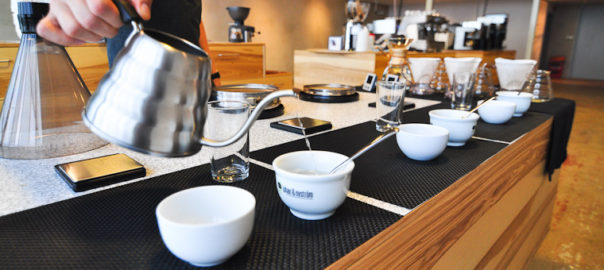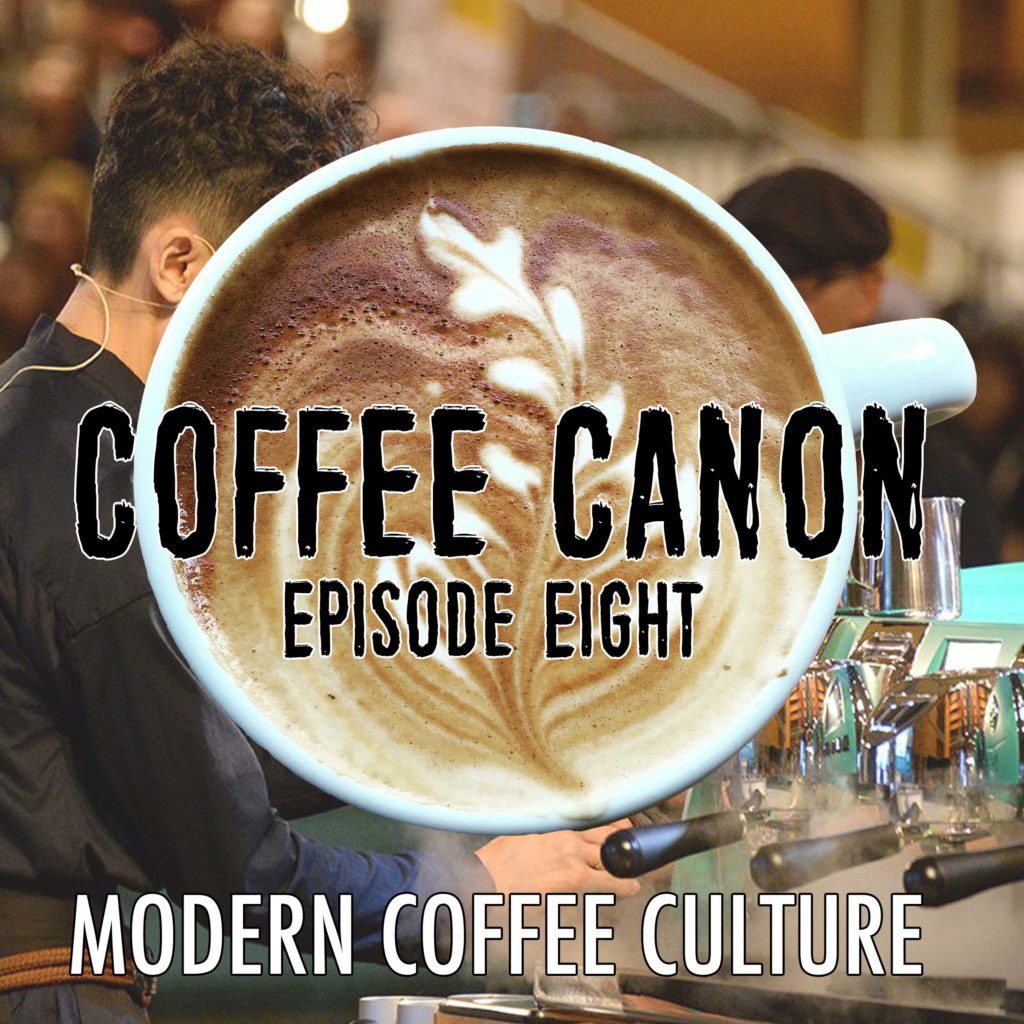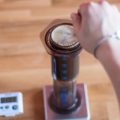The way we drink and experience coffee has changed drastically. To many people, it’s become a specialty beverage where taste not only matters, but is decrypted using a multi-tiered tasters wheel consisting of 73 individual flavors. Cafes today focus not just on profit margins, but on growing standards and fair wages for farmers. Baristas take their craft seriously, competing against each other for trophies shaped like espresso tampers and portafilters. So…how’d we get here?
Episode Eight Sources:
- “Norway and Coffee,” The Flamekeeper, by Trish Rothgeb https://web.archive.org/web/20031011091223/http://roastersguild.org/052003_norway.shtml
- “About Us,” Wrecking Ball Coffee Roasters https://www.wreckingballcoffee.com/pages/about-us
- “What is ‘Third Wave Coffee’, & How Is It Different to Specialty?” Perfect Daily Grind, by Julio Guevara https://www.perfectdailygrind.com/2017/04/third-wave-coffee-different-specialty/
- “The Three Waves Of Coffee,” Coffee Kind https://coffeekind.com/blogs/the-reading-room/the-three-waves-of-coffee
- “The Future of Specialty Coffee and the Next Wave,” Coffee Talk, by Timothy J. Castle http://coffeetalk.com/ctmagazine/01-2016/21518/
- “Do You Know Trish Rothgeb?” Fresh Cup Magazine, by Ellie Bradley https://www.freshcup.com/do-you-know-trish-rothgeb/
- “In San Francisco, Wrecking Ball Coffee’s Making Better Less Cool,” Sprudge, by Michael Light http://sprudge.com/in-san-francisco-wrecking-ball-coffees-making-better-less-cool-87750.html
- “Trish Rothgeb On The State of Specialty Coffee,” Imbibe Magazine, by Penelope Bass http://imbibemagazine.com/trish-rothgeb/
- “I Want Coffee, Not Coffee,” The Specialty Coffee Chronicle Issue 4, by Nicholas Cho https://www.scribd.com/doc/62935061/Doing-Good-and-Making-Change-Chronicle-Issue-4
- “2018 World Barista Championship Official Rules and Regulations, Version 2018.01.23.” https://www.dropbox.com/s/anqulrq9v090n4b/2018%20WBC%20Rules%20and%20Regulations-JAN23.pdf?dl=0
- World Barista Championship, https://worldbaristachampionship.org/world-barista-championship-amsterdam-2018/
- “What Goes Into Competition Preparation”, Origin, by Winston http://originroasting.co.za/v3/goes-competition-preparation/
- US Coffee Championships Timeline http://www.uscoffeechampionships.org/timeline/
- “The BGA and the Third Wave,” CoffeeGeek.com, by Nicholas Cho http://coffeegeek.com/opinions/bgafiles/04-02-2005/
- “Why Do Americans Drink Half As Much Coffee Today As They Did 60 Years Ago?” Zócalo Public Square, by Murray Carpenter http://www.zocalopublicsquare.org/2014/04/21/why-do-americans-drink-half-as-much-coffee-today-as-they-did-60-years-ago/ideas/nexus/
- “The State of Blogging,” Pew Research Center, by Lee Rainie http://www.pewinternet.org/2005/01/02/the-state-of-blogging/
- “Dale Harris Is The World Barista Champion 2017,” European Coffee Trip, by Karolina Kumstova https://europeancoffeetrip.com/dale-harris-world-barista-champion-2017/
- “World Barista Championship 2017 – Final Round – Dale Harris (Champion),” YouTube.com, Uploaded by Muhammad Zain Tajuddin: https://www.youtube.com/watch?v=0iiMZmdaPBg
- Wikipedia
- “Third wave of coffee” https://en.wikipedia.org/wiki/Third_wave_of_coffee
- “Google” https://en.wikipedia.org/wiki/Google
- Music
- Chad Crouch, Button – http://freemusicarchive.org
- Podington Bear, 14 Rarified – http://freemusicarchive.org
- Podington Bear, The Confrontation – http://freemusicarchive.org
- Cover Art Photo Credit
- “Event: World Barista Championship 2017,” Loveramics, by eshop Loveramics https://www.loveramics.com/blogs/journal/event-world-barista-championship-2017
Episode Eight Transcript:
“You can’t know where you’re going until you know where you’ve been.” This old saying gets tossed around a lot – and interestingly, there doesn’t seem to be any one source for its origin. More than likely, its an amalgamation of several real quotes, like this one from American novelist James Baldwin: “Know from whence you came. If you know whence you came, there are absolutely no limitations to where you can go.” Or this one, from Irish statesman Edmund Burke, “Those who don’t know history are doomed to repeat it.” Or even, perhaps this one from English fantasy novelist Terry Pratchett, “If you do not know where you come from, then you don’t know where you are, and if you don’t know where you are, then you don’t know where you’re going. And if you don’t know where you’re going, you’re probably going wrong.”
The goal of this podcast is in the name – Coffee Canon. We’re here to discuss the canon – the real events that happened as they’re described – surrounding coffee. We’ve spent a great deal of time focusing on the distant past, going back to as far as the 15th century. Surprisingly though, for as long as coffee has been around, some of the biggest leaps in its production, distribution, roasting, and brewing have happened within the last 70 years or so. Espresso, for example, didn’t even exist until the 1950s.
But even more recently, the way we drink and experience coffee has changed drastically. To many people, it’s become a specialty beverage where taste not only matters, but is decrypted using a multi-tiered tasters wheel consisting of 73 individual flavors. Cafes today focus not just on profit margins, but on growing standards and fair wages for farmers. Baristas take their craft seriously, competing against each other for trophies shaped like espresso tampers and portafilters.
Coffee has changed. And in 2002, Trish Rothgeb from Wrecking Ball Coffee Roasters defined this change by coining the term “Third Wave Coffee.”
The canon we’ve looked at so far relates to coffee’s past. On this episode, we’re focusing on modern coffee culture.
I’m Colin Mansfield, and welcome to Coffee Canon.
“November, 2002: The final night of Oslo’s preliminary rounds for the Norwegian Barista Championships. The last competitor steps up to the bar to begin his 10 minutes of prep time. He looks nothing like the others. No trendy hairdo, no expensive jeans or silver-studded eyebrow. As a matter of fact, he is not a working barista at all. Looking more like a shorter, jollier Pappa Hemingway, he is Alf Kramer (among other things: the former chairman and founder of The SCAEurope, past director of The Norwegian Coffee Association, a champion of coffee causes worldwide, and Norway’s father of coffee’s Second Wave). He is competing tonight against kids 30 years his junior. Some weren’t even born when he began working in Specialty Coffee, and many don’t even really know who he is. So why is he here? Could be he knows the Third Wave of coffee is swelling in Norway and he’s here to surf some crema.
First Wave, Second Wave, Third Wave: this is how I think of contemporary coffee. There seem to be three movements influencing what Erna Knutsen, a Norwegian immigrant to America, termed Specialty Coffee. Each approach has its own set of priorities and philosophies; each has contributed to the consumer’s experience—and our livelihoods. Occasionally, the waves overlap; and one inevitably spills over to influence the next. What have we chosen to accept as conventional coffee wisdom? What have we rejected? What does the next wave have to offer?”
These words, written by Trish Rothgeb are the first recorded mention of the term “Third Wave Coffee.” This phrase, and the historical concept it harkens to, are the foundation upon which modern coffee culture is built. There’s an attractive simplicity to distilling coffee’s history into three sections – and while it’s not perfect, it does give an accessible framework to how coffee got to where it is today. To put it simply: it makes modern coffee easier to explain.
So who is Trish Rothgeb and why does her description of coffee’s history matter?
For starters, Trish is the co-founder, co-CEO, director of coffee, and roastmaster at Wrecking Ball Coffee Roasters in San Francisco. She has over 30 years of experience as a coffee roaster, green coffee buyer, and teacher of most anything to do with coffee. She teaches cupping to coffee producers and professionals around the world, and she travels often to growing regions worldwide. She served on the Specialty Coffee Association of America’s Roasters Guild Executive Council, was a charter member of the World Barista Championship Board of Directors, and a founding member of the Barista Guild of America. And those are just the highlights.
According to an interview she conducted with Fresh Cup Magazine in 2016, Trish got her start in coffee working as a barista during college while studying painting and drawing at San Jose State University in California. In 1990 she learned how to roast coffee on a small roaster. According to her, “This is before it was a cool thing to do. It was just a weird thing to do.” She asked her boss to teach her how to roast. He responded, “I would rather golf in the morning so sure, I’m going to give you this job and I’m going to teach you how to turn this machine on and make this coffee as black as tar and that’s how I want you to roast it.”
Trish never stopped working in coffee – it hooked her. She learned all she could from various jobs in the U.S., but a trip overseas opened her eyes. “…I went to Europe and it was like a whole new world, just so much information. I had already been in coffee for ten years when I went to Norway and when I got there I was like, what the hell is going on? This is a whole different world. Like what are these cappuccinos? They’re perfection. That’s when I got a new flood of interest.”
In an interview with Imbibe Magazine, Trish explains where she got the phrase “Third Wave Coffee” from.
“Back around 2000, while I was living in Oslo, Norway, I was reading some random articles about third-wave feminism. In a nutshell, the concept said that you could be whatever you want to be – that we can build on what we had learned from feminism of the past few decades, and then shed some of the ideas that no longer worked. I also saw espresso being served in a few shops in Oslo that aligned with that philosophy…The shops couldn’t care less about how the older more established cafes were doing it, whether they were ‘authentically Italian,’ or even if they had a large and loyal customer base…this dedication to the highest quality possible, in harmony with cafes’ point of view, was entirely new to me. It all of a sudden seemed logical that coffee, much like artisan breads or craft beer and cheese, would want to continue to push for greater heights.”
The other half of Wrecking Ball Coffee Roasters is Nick Cho. He’s the co-founder, co-CEO, and head barista. In 2002 Nick founded Murky Coffee, which developed into Washington DC’s premier coffee bar, winning barista competitions and recognition around the specialty coffee industry. Nick’s resume is just as impressive as Trish’s: he’s served as a director on the Barista Guild of America’s Executive Council, on the Specialty Coffee Association of America’s Board of Directors, on the World Barista Championship Board of Directors, and as the chair of the United States Barista Championship.
Nick and Trish are two sides of a well-polished coin. Trish is a technical expert. When asked by Fresh Cup magazine whether or not she holds public cuppings at Wrecking Ball, she responded “It’s an occupational hazard for me to talk to the lay person about coffee…if I had the time and space I would train either my head trainer or my lead barista to do those with customers and they would love it and the baristas would love doing it. That’s a better application of my time than to try to do it myself and be nervous because people aren’t rinsing their spoons or not doing something else. I’m so totally focused on the technical that I’m just a fish out of water anymore in that space.”
Nick, on the other hand, is a front-end man, focused on relating to customers, service, and making specialty coffee more approachable. In a 2011 issue of The Specialty Coffee Chronicle Nick wrote an article titled, “I Want Coffee, Not Coffee Or: How I Learned to Appreciate Cream and Sugar Again.” In it, Nick discusses the disconnect between specialty coffee enthusiasts, and the average customers they are trying to serve. The article is a great quick read, but I’ll pull out a couple quotes that best illustrate his point:
“Expecting customers to stop and engage us on our terms because we want to teach them about coffee is beyond unrealistic. It clearly crosses the line into arrogance, if not ignorance.” Also, “Neither the coffee purists nor the populists would, or should, want to see the other side disappear. With the plight of the coffee farmers on all of our minds, diversity in the ways people consume and enjoy coffee is good for everyone. However, what isn’t good for everyone is the polarization and dissension, that has become all too common as our industry grows and develops. If we’re to reach our customers effectively, we need to figure out how to communicate coffee factually, accurately, and in ways that clarifies the truth, rather than promoting more confusion.”
Trish Rothgeb and Nick Cho aren’t the only influential people in the coffee industry by a long shot, but their impact can’t be overstated. They’ve helped shape modern coffee culture into what it is today, and they continue to challenge their peers through strong opinions and thoughtful discussion. You can find a host of articles, interviews, and opinion pieces written by Nick and Trish on the “About Us” page on their website, wreckingballcoffee.com.
This week from June 20th-23rd, 60 barista champions from around the globe will meet in Amsterdam to compete at the 2018 World Barista Championship. Their challenge is to prepare 4 espressos, 4 milk drinks, and 4 original signature drinks to exacting standards – and they have 15 minutes to accomplish this.
The rules and regulations for the World Barista Championship are laid out in a 25-page document that outlines all kinds of criteria that competitors must follow. For example, in the “Technical Skills Espresso – Part II” section, baristas must abide by the following in order to score maximum points: flush the group head, dry-clean filter basket before dosing, acceptable spill/waste when dosing/grinding, consistent and effective dosing and tamping, cleans portafilters (before insert), insert and immediate brew, and extraction time (within 3 second variance). There are 18 sections in the rules booklet with criteria like these – its nothing if not thorough.
As with any competition, though, the hard part isn’t the 15 minutes on stage – its all the prep work that happens months in advance.
It’s important to realize that the World Barista Championship doesn’t pick a coffee for competitors to brew. Instead, each competitor must select an excellent coffee that 1) tastes delicious and 2) fits in with a theme they’ve chosen. Ideally, competitors will build their entire 15 minute demonstration around this theme. It could be highlighting new processing techniques, explaining how specific equipment changes their cup, or even simply discussing their personal specialty coffee journey. But whatever that theme is, the coffee needs to be the center piece.
As you know from previous episodes of this podcast, coffee growing, processing, and roasting is a time-consuming process. This means that baristas need to build in plenty of time in their training schedule to account for selecting a coffee, cupping different roasts, and practicing actually brewing that coffee.
At the same time, the competing baristas aren’t brewing their coffee in silence. During their 15 minutes on stage, competitors are explaining every step and how it relates to their theme. This means that not only do they have to be great at making coffee, but they also have to hone their presentation skills to perfection. If you ever watch the World Barista Championship, you’ll notice that competitors have a cadence and rhythm to what they’re discussing – and its all in perfect sync with how they’re brewing. That level of performance only comes as a result of hundreds of hours of practice.
In a second I’m going to play a clip for you from last year’s World Barista Championship. In it, you’ll hear Dale Harris, the Director of Wholesale at Hasbean Coffee, go through the last portion of his routine for the final round of the competition. It’s important to note that to get to this point, first Dale competed in and won the Barista Championship of the United Kingdom. Next, he competed in four days at the World Barista Championship consisting of two days of preliminary rounds, a day of competition against 16 baristas for the semi-finals, and this – the final round where just 6 competitors remained.
In this clip Dale is making his “signature drink.” The signature drink is a unique invention by each barista, which highlights specific qualities in the coffee they’ve chosen and fits in with their theme. While he’s talking, Dale is being evaluated by a panel of four judges. Here he is:
[Dale Harris World Barista Championship audio clip – watch full video here]
The first US Coffee Championship took place in 2002. A group of dedicated volunteers organized the first North American Barista Championship at the Specialty Coffee Association of America Exposition in Anaheim, California. 27 baristas from around the US competed. By the next year, this organization became the representative body for the World Barista Championship in America. They organized a series of 10 regional barista competitions across the US which fed the national event – this same competition format was used until 2010.
In 2010 the World Barista Championship reorganized itself as “World Coffee Events.” They incorporated cup tasting and latte art competitions, and by doing so, further broadened opportunities for baristas to compete. The next year, in 2011, the 10 regional competitions were consolidated into six, and the US Brewers Cup Championship was introduced into the competition cycle.
In 2013 the American competition rebranded itself as the US Coffee Championships. The six regional competitions were further consolidated into just three “big” events. While community feedback continued to be largely positive towards these changes, the Specialty Coffee Association of America was experiencing a significant drain on their financial resources. The competitions had grown so large that costs were exceeding revenues.
2015 was a big year of change for the US Coffee Championships. Regional events were completely eliminated – they simply weren’t financially viable. A new process for qualifying competitions was announced, and was immediately met by protests from the barista community. After a series of leadership summits, meetings, and community feedback, a single qualifying event was created to determine competitors advancing to the national championships.
In 2016 the US Coffee Championship qualifying event took place in Kansas City, Missouri. 100 coffee professionals competed to qualify for the US Barista Championship, and 50 for the US Brewers Cup competition. Of these 150, 36 from each competition were selected as eligible to advance.
Later that year, the Competitions Committee reconvened to develop a long-term solution for regional qualifications. One issue that had been brought up over the years was how to give all coffee professionals the same chance to compete – regardless of where they’re from. Ultimately, the committee came up with a financially viable solution that is community-focused. They’re called “CoffeeChamps,” and in 2017 two of these qualifying events were held in Knoxville, TN and Austin, TX.
Obviously, coffee competitions aren’t for everyone – most people drink coffee largely the same way humans have for hundreds of years. We’re not interested in being on stage, or trying to convince judges why we deserve a trophy: most people, and this includes me, just want a good cup of coffee. And today, more then ever before in coffee’s history, getting your hands on a truly great cup is easy. You could say that this is due to a greater societal awareness about what goes into producing quality goods. You could also probably argue that the marketing focus on organic, fair-trade, and other similar labels has made consumers more willing to buy expensive coffee beans. Both of these things are probably true, and I think you could probably find other equally true statements regarding why more great coffee is available now.
But I actually think that there is one root cause. Usually, when we talk about the other two waves of coffee, what they are is closely tied to why they are. For example, the first wave of coffee, according to Trish Rothgeb, is defined by air-tight cans, pre-ground portion packs, and making coffee a commodity available to the masses. World War I and World War II were vitally important to this phase because coffee was seen as a morale-booster for troops oversees, and was rationed back in the US. After World War II, in 1946 coffee consumption in the US peaked at over 46 gallons per person annually. This huge demand for coffee meant companies had to come up with new ways to package, sell, and ship beans. The first wave of coffee is defined by its causes.
The second wave is generally associated with the rise and prominence of Starbucks, and similar large-scale coffee chains. The things that define the second wave of coffee, according to Trish, start with an artisan-style drive towards caring about coffee’s origins. Paying closer attention to roasting styles is another marker of second wave coffee. Starbucks introduced words like “latte” and “cappuccino” into the vernacular of everyday Americans, not to mention “tall, grande, and venti.” Once again, the second wave of coffee is defined by what caused it to unfold.
And yet, with the third wave of coffee, while there are plenty of discussions, debates, and articles centered on what it is (it’s definition), there are shockingly few discussions about why it is. Sure, people reference how it got its name, who some of the big players are, and what a third wave cup of coffee tastes like, but the why is rarely brought up.
My hypothesis for why the third wave of coffee exists is simple: the internet. Or, to put it more accurately, the modern, searchable internet.
The timelines definitely match up: between 2000-2005 Google became the search engine power-house of the internet. This was about the same time Trish Rothgeb was relating her thoughts on third-wave feminism to coffee. This was also around the time Nick Cho founded his Washington D.C.-based coffee bar. In 2005 Nick actually expanded on Trish’s Third Wave Coffee concept in an online forum post to CoffeeGeek.com. In it, Nick says “So what of this ‘Third Wave?’ In an admittedly esoteric way, I usually refer to the ‘Third Wave’ as letting the coffee speak for itself. During the first two waves, we appreciated coffee for what it gives us: caffeine, a hot beverage to sip and enjoy a conversation over, a drink to modify with sweetener, dairy (or non-dairy) creamers, syrups, whipped cream, etc. The Third Wave is about enjoying coffee for what it is.”
But did you catch that? Nick Cho posted that on an online forum, completely centered on coffee discussion, in 2005. The early 2000’s were formative years for the modern internet, but that year – 2005 – was a tipping point. According to a Pew Research Center article written on January 2nd, 2005, “By the end of 2004 blogs had established themselves as a key part of online culture. Two surveys by the Pew Internet & American Life Project in November established new contours for the blogosphere and its popularity.” They go on to list some interesting statistics.
“27% of internet users say they read blogs, a 58% jump from the 17% who told us they were blog readers in February. This means that by the end of 2004 32 million Americans were blog readers…At the same time, for all the excitement about blogs and the media coverage of them, blogs have not yet become recognized by a majority of internet users. Only 38% of all internet users know what a blog is.”
The outer limit of what communicating with other people on the internet looked like at the beginning of 2005 was blogs and online forums. In February of 2005, YouTube came online. Also in February, Google Maps was launched. In June, Reddit launched. In September, a little online college project opened up to high schools across the US – called Facebook. By the end of 2005, Facebook was in over 2,000 universities and 25,000 high schools throughout the US, Canada, Mexica, the United Kingdom, Australia, New Zealand, and Ireland.
Google had grown significantly in the early 2000s, becoming the definitive search engine of the modern internet. The first use of “Google” as a verb in pop culture happened on Buffy the Vampire Slayer in 2002. Then, in 2005, The Washington Post reported a 700 percent increase in third-quarter profit for Google. Most of this profit came from companies shifting advertising strategies online, and away from newspapers, magazines, and television.
By the end of 2005 the way you could interact with people online, share content, and view media had radically changed. The internet would certainly never be the same, but neither would the way humans share ideas and knowledge. Blogs opened a way for the layman to share their ideas with a larger community of people. Facebook made that even easier, giving you a one-stop-shop for friends, co-workers, and classmates. YouTube made it so you could expand on ideas using videos and visual media. Reddit created a voting system for people to decide what content is important and most worth viewing. But Google really ties this all together – search is the lynchpin of the internet – it makes things possible to find, and allows anyone dsto begin the process of self-education.
Modern coffee culture isn’t defined by a societal event like a world war, nor is it defined by any one company like Starbucks. Instead, it’s defined by the ability to share information with people across the world in an instant. It’s defined by getting feedback on brew methods and roast recipes online. It’s being able to write, record, and publish an audio show about coffee’s history, then having that instantly available for anyone to listen to. Nick Cho said, “The Third Wave is about enjoying coffee for what it is.” I agree, but respectfully I’d argue it needs more. The Third Wave is about enjoying coffee for what it is, and sharing that enjoyment with anyone, instantly. Without the internet, there are no World Barista Championships or coffee competitions. Without the internet, and the communities built around a passion for coffee, there is no Third Wave.
Thanks for listening to Coffee Canon. I’m your host, Colin Mansfield, and I hope you enjoyed listening to this episode as much as I enjoyed making it. If you’d like to discuss more about modern coffee culture, find me on Twitter – my handle is @BoiseCoffee. And if you liked this episode, please leave it a review on Apple Podcasts so other people can find it. Have an awesome week!
Podcast: Play in new window | Download
Subscribe: Apple Podcasts | Android | RSS




